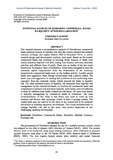Please use this identifier to cite or link to this item:
https://cris.library.msu.ac.zw//handle/11408/1428Full metadata record
| DC Field | Value | Language |
|---|---|---|
| dc.contributor.author | Chikoko, Laurine | - |
| dc.date.accessioned | 2016-05-20T08:07:37Z | - |
| dc.date.available | 2016-05-20T08:07:37Z | - |
| dc.date.issued | 2014 | - |
| dc.identifier.issn | 2305-8277 | - |
| dc.identifier.uri | http://jcibr.webs.com/Archives/Volume-2014/Issue-1-january/Article-V-3-N-1-052013JCIBR0036.pdf | - |
| dc.identifier.uri | http://hdl.handle.net/11408/1428 | - |
| dc.description.abstract | This research presents a comprehensive analysis of Zimbabwean commercial banks potential sources of liquidity risk after the country adopted the multiple currency exchange rate regime (March 2009 to December 2012). A survey research design and documentary analysis were used. Based on the results, commercial banks had problems in sourcing funds. Sources of funds were mainly transitory deposits with little coming from treasury activities, interbank activities and offshore lines of credit. There was no lender of the last resort function by the Reserve Bank of Zimbabwe. Some banks struggled to raise the minimum capital requirements. After the dollarisation of the economy, progressively commercial banks took up the lending activity. Locally owned banks were aggressive while foreign owned banks took a passive stance. The banks that were aggressive in lending had problems of non-performing loans especially from the corporate clients, which exposed the banks to liquidity risk. The other potential source of liquidity risk emanated from liquidity risk management by the commercial banks. As much as all commercial banks had comprehensive policies and procedure manuals, some banks were not adhering to them. In addition some banks violated set risk limits. All these were threats to liquidity management by commercial banks in Zimbabwe. The main recommendation of this study is that banks may need to come up with products and devices that encourage clients to have a savings culture. The central bank may not need to be too strict or too relaxed but to be moderate and ensure an enabling regulatory environment. This would facilitate banks to manage liquidity risk and at the same time protect depositors in any challenging operating environment. | en_US |
| dc.language.iso | en | en_US |
| dc.publisher | Academic Journals | en_US |
| dc.relation.ispartofseries | Journal of Contemporary Issues in Business Research;Vol. 3, No. 1; p. 41-51. | - |
| dc.subject | Zimbabwe; Commercial Banks; Illiquidity; | en_US |
| dc.subject | Multiple Currency; Exchange rate | en_US |
| dc.title | Potential sources of Zimbabwe commercial banks liquidity after dollarisation | en_US |
| dc.type | Article | en_US |
| item.grantfulltext | open | - |
| item.cerifentitytype | Publications | - |
| item.openairecristype | http://purl.org/coar/resource_type/c_18cf | - |
| item.openairetype | Article | - |
| item.fulltext | With Fulltext | - |
| item.languageiso639-1 | en | - |
| Appears in Collections: | Research Papers | |
Files in This Item:
| File | Description | Size | Format | |
|---|---|---|---|---|
| Article-V-3-N-1-052013JCIBR0036.pdf | Abstract | 744.24 kB | Adobe PDF |  View/Open |
Page view(s)
246
checked on Nov 23, 2025
Download(s)
72
checked on Nov 23, 2025
Google ScholarTM
Check
Items in MSUIR are protected by copyright, with all rights reserved, unless otherwise indicated.



